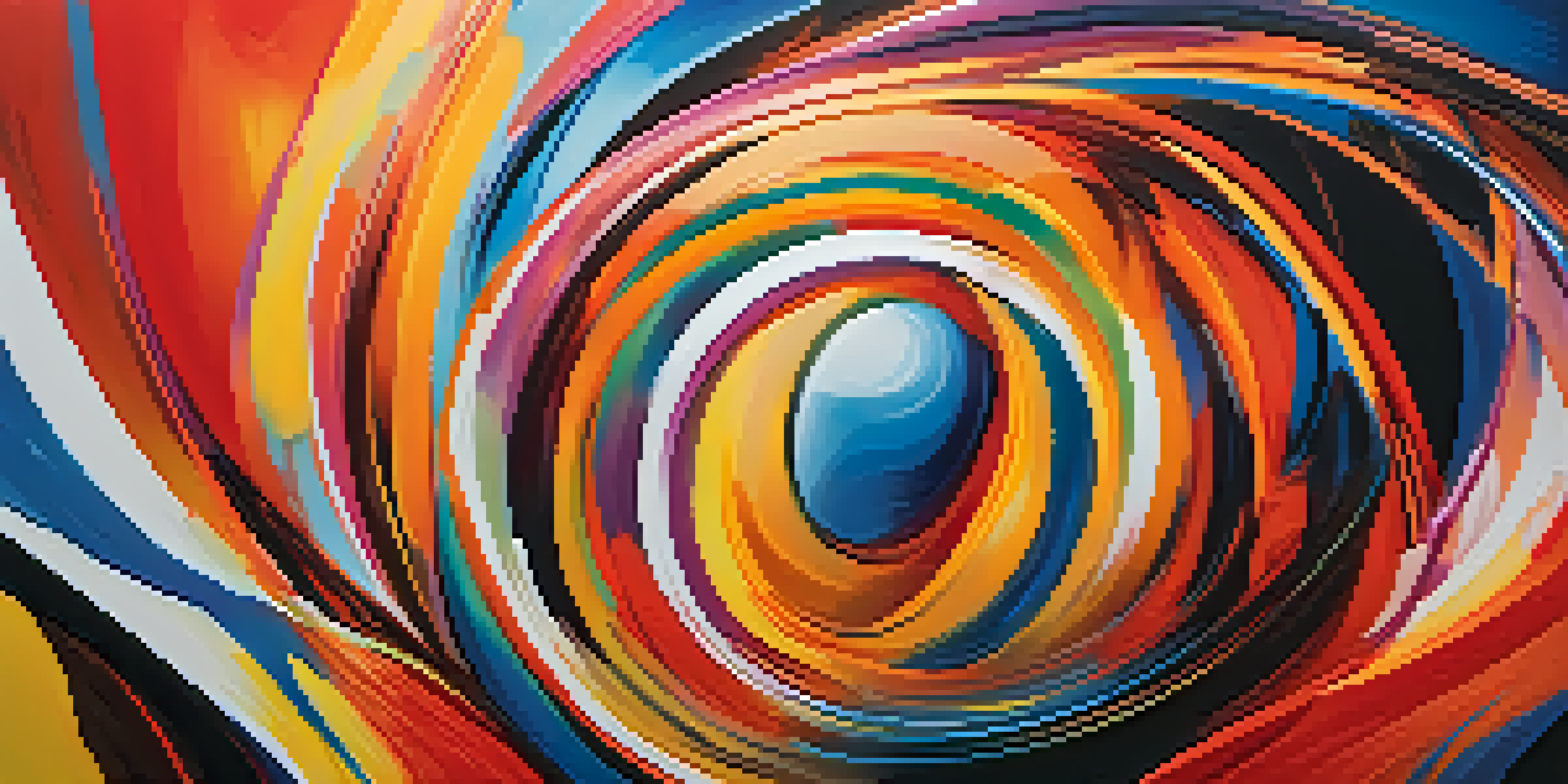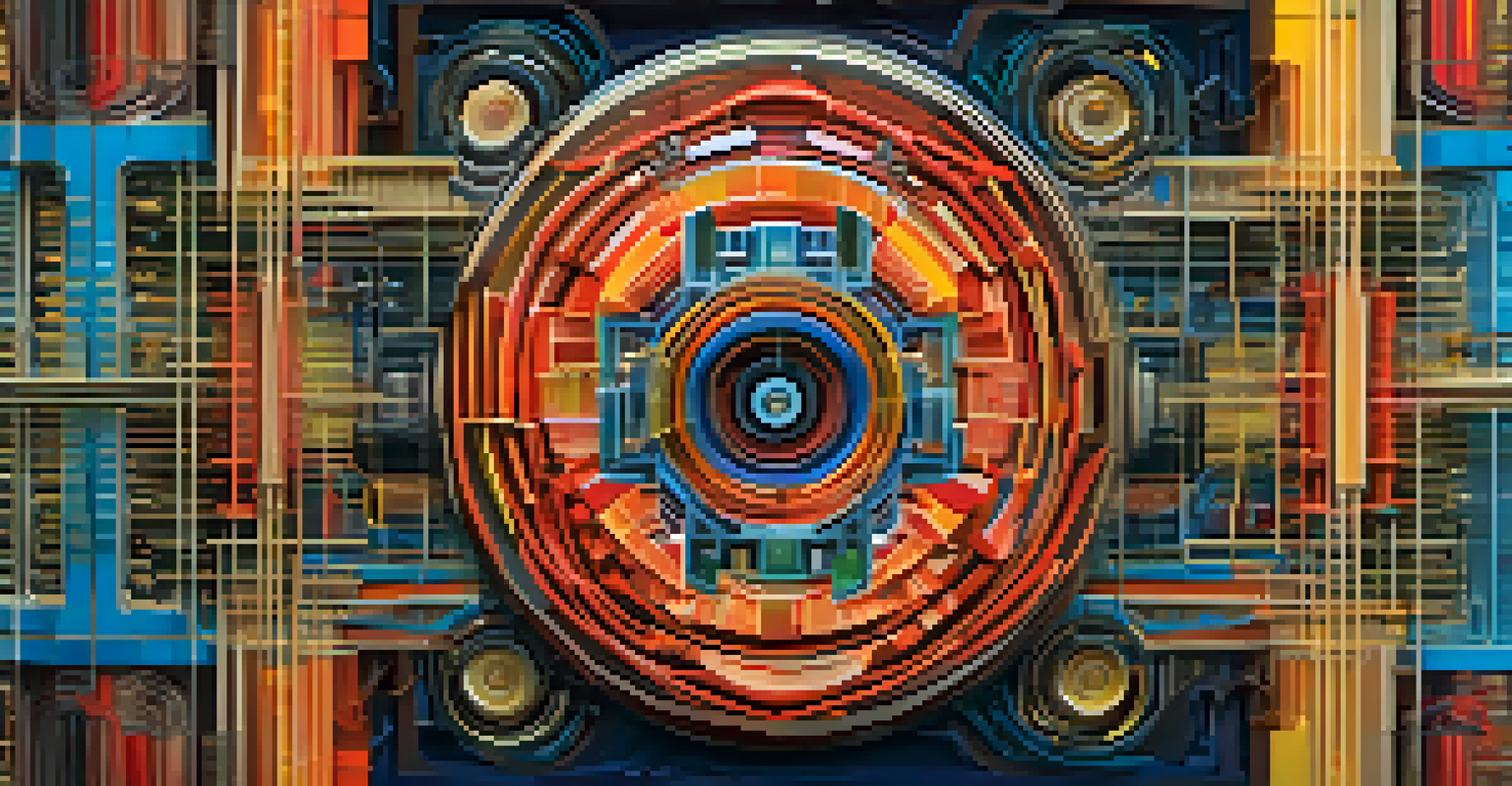The Evolution of Abstract Art in the 20th Century

Understanding Abstract Art: A Definition and Overview
Abstract art is a form of art that does not attempt to represent an accurate depiction of visual reality. Instead, it focuses on shapes, colors, and forms to evoke emotions or ideas. This genre emerged as artists sought to break free from traditional artistic conventions, allowing for a more personal expression.
Abstract art enables the artist to perceive beyond the tangible.
The early 20th century marked a pivotal moment for abstract art, where artists began to explore the relationship between art and perception. Think of it as moving from a clear photograph to a dreamlike blur; the essence remains, but the interpretation changes. This shift was influenced by various movements, including Impressionism and Cubism, which paved the way for abstraction.
As abstract art evolved, it became a platform for artists to challenge societal norms and express complex thoughts. It encouraged viewers to engage with art on a different level, inviting personal interpretation rather than providing a clear narrative. This dynamic interaction between the artwork and the observer is one of the key features that makes abstract art so compelling.
The Rise of Abstract Expressionism in the 1940s and 50s
Abstract Expressionism emerged in the United States after World War II, marking a significant shift in the art world. Artists like Jackson Pollock and Mark Rothko became prominent figures, using vibrant colors and bold forms to convey deep emotions. This movement was characterized by spontaneous and expressive brushwork, giving a sense of freedom and individuality.

Pollock's drip paintings, for instance, transformed the canvas into a field of chaotic energy, inviting viewers to immerse themselves in the process of creation. Imagine standing in front of a massive canvas, feeling the tension and release of each splatter; it's an experience that transcends traditional viewing. This sense of immediacy and raw emotion resonated with audiences and reflected the societal sentiments of the time.
Abstract Art Breaks Traditional Norms
Abstract art prioritizes shapes and colors over realistic depictions, allowing for personal interpretation and emotional expression.
As Abstract Expressionism gained traction, it also sparked debates about the nature of art itself. Critics and artists alike questioned whether emotion could be effectively conveyed without representational forms. This discourse contributed to the ongoing evolution of abstract art, pushing boundaries and redefining what art could be.
The Influence of Geometric Abstraction in the 1960s
In the 1960s, geometric abstraction emerged as a counterpoint to the emotional intensity of Abstract Expressionism. Artists like Piet Mondrian and Josef Albers focused on simplicity and order, using geometric shapes and primary colors to create harmony. This movement emphasized clarity and precision, presenting a stark contrast to the chaotic styles that preceded it.
The artist is not a different kind of person, but every person is a different kind of artist.
Geometric abstraction can be likened to a well-structured symphony, where each note is carefully placed to create a cohesive whole. This approach appealed to those who sought a more rational understanding of art, allowing viewers to appreciate the beauty in form and composition. The clean lines and balanced forms of geometric abstraction often evoke a sense of calm and contemplation.
As this movement gained popularity, it also influenced architecture and design, leading to a broader cultural appreciation for minimalism. The principles of geometric abstraction can be seen in everything from furniture design to urban planning, highlighting the movement's lasting impact. This shift towards clarity not only shaped art but also permeated various aspects of modern life.
The Emergence of Minimalism and Its Artistic Philosophy
Minimalism took root in the late 1950s and continued into the 1970s, promoting the idea that less is more. Artists like Donald Judd and Agnes Martin stripped away the unnecessary, focusing on essential forms and colors to convey meaning. This movement challenged the notion of art as a complex narrative, inviting viewers to find beauty in simplicity.
Imagine walking into a gallery filled with stark, unembellished artworks; the absence of distraction allows for deeper contemplation. Minimalism encourages viewers to engage with each piece on a fundamental level, often prompting a personal connection to the work. This focus on purity and essence invites a new appreciation for the materials and methods used in creation.
Technology Redefines Art Creation
The integration of digital tools in contemporary abstract art expands creative possibilities and democratizes artistic expression.
The minimalist philosophy also influenced various fields, including music, architecture, and design, allowing its principles to resonate beyond the art world. By emphasizing intentionality and clarity, minimalism continues to inspire contemporary artists and creators, proving that simplicity can hold profound meaning.
Postmodernism: Challenging the Boundaries of Abstract Art
As the 1980s rolled in, Postmodernism emerged as a response to the established norms of art, including abstraction. Artists began to question the very foundations of art, blending different styles and mediums to create works that defied categorization. This movement highlighted the idea that art could be anything, challenging the notion of a singular artistic identity.
Postmodern abstract art often incorporates elements of popular culture, adding layers of meaning and context. Imagine a canvas filled with graffiti, collage, and traditional painting techniques; this fusion reflects a society that values diversity and complexity. By breaking down barriers, Postmodern artists invited audiences to engage with art in new and unexpected ways.
This era also marked a shift towards inclusivity and representation, with artists from diverse backgrounds contributing to the conversation. The blending of various influences created a rich tapestry of artistic expression, emphasizing that abstract art is not confined to a single narrative or style. This evolution continues to shape contemporary art, reminding us that creativity knows no boundaries.
The Role of Technology in Contemporary Abstract Art
With the advent of technology in the late 20th and early 21st centuries, abstract art has taken on new dimensions. Digital tools allow artists to experiment with forms and colors in ways that were previously unimaginable. Techniques such as digital painting and 3D modeling have expanded the possibilities for creative expression, pushing the boundaries of what we consider art.
Consider how a digital artist can manipulate pixels and layers to create intricate, dynamic images that challenge traditional definitions of abstraction. This integration of technology not only enhances artistic possibilities but also reaches a wider audience through online platforms. The accessibility of digital art has democratized the art world, allowing more voices to be heard.
Future Trends in Abstract Art
Emerging technologies like AR and VR are set to transform how we experience abstract art, fostering greater cultural exchange and innovation.
Contemporary artists are now blending traditional methods with digital innovations, creating hybrid works that reflect our increasingly interconnected world. This evolution signifies a departure from conventional practices, encouraging dialogue about the nature of art in the digital age. As technology continues to advance, it will undoubtedly shape the future of abstract art in exciting and unpredictable ways.
The Future of Abstract Art: Trends and Predictions
As we look to the future, the evolution of abstract art is likely to continue in fascinating directions. Emerging trends such as augmented reality (AR) and virtual reality (VR) are set to redefine how we experience and interact with art. These innovations pave the way for immersive environments where viewers can engage with abstract concepts in a three-dimensional space.
Furthermore, as global connectivity increases, we can expect a broader range of cultural influences to shape abstract art. Artists from different backgrounds will continue to push the boundaries of traditional practices, creating a rich dialogue that reflects our diverse society. This interconnectedness can lead to the emergence of new styles that blend various artistic traditions.

Ultimately, the future of abstract art will likely challenge and inspire us in ways we cannot yet imagine. As artists continue to explore new mediums and ideas, they will invite us to question our perceptions and engage with the world around us. This ongoing journey of abstraction reminds us that art is a living, breathing entity that evolves alongside humanity.